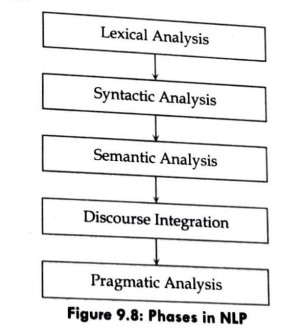Explain the phases NLP.
1. lexical Analysis and Morphological: The first phase of NLP is the Lexical Analysis. This phase scans the source code as a stream of characters and converts it into meaningful lexemes. It divides the whole text into paragraphs, sentences, and words.
2. Syntactic Analysis (Parsing): Syntactic Analysis is used to check grammar, word arrangements, and shows the relationship among the words. Example: Arjun goes to the Radha In the real world, Arjun goes to the Radha, which does not make any sense, so this sentence is rejected by the Syntactic analyzer.
3. Semantic Analysis: Semantic analysis is concerned with the meaning representation. It mainly focuses on the literal meaning of words, phrases, and sentences.
4. Discourse Integration: Discourse Integration depends upon the sentences that proceed it and also invoke the meaning of the sentences that follow it.
5. Pragmatic Analysis: Pragmatic is the fifth and last phase of NLP. It helps you to discover the intended effect by applying a set of rules that characterize cooperative dialogues. For Example: "Open the door" is interpreted as a request instead of an order.




Comments
Post a Comment